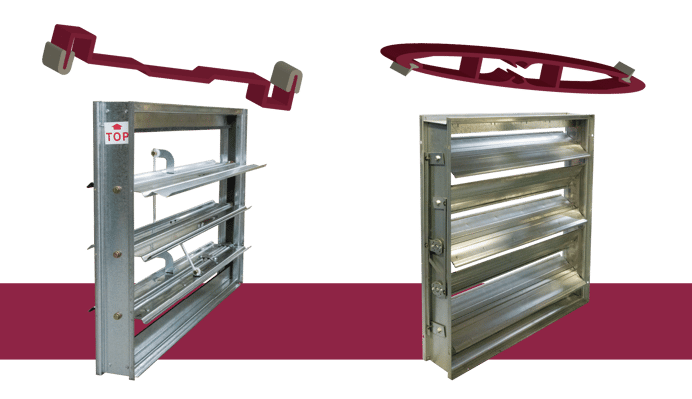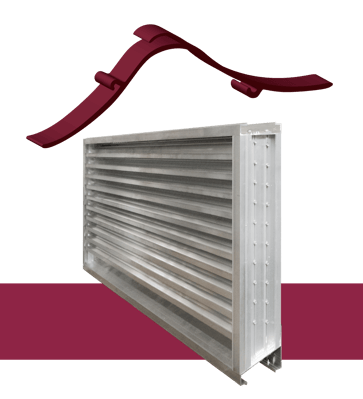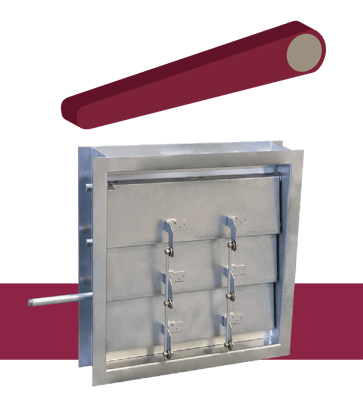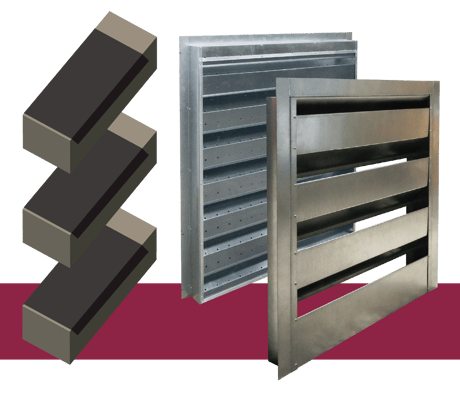Every blade is built with a purpose. In this article, we look at a few specialty blades and what they do in your HVAC system.
Blades make up the core of every louver and damper. Their shape and type will always affect how the unit performs. For instance, a louver blade with drain catches along its profile will reject rainwater better than a blade with a smooth profile. Drain catches will also affect its air performance by lowering its overall free area and increasing its pressure drop.
Every blade will work best in a particular role in your HVAC system, but there are some blades designed for a specific purpose.
For more louvers and dampers, check out these other Newsstand articles:
- The Condenser - Chevron Blades for Severe Weather
- The Condenser - A Closer Look at Linkage
- Important Terms for Louvers and Dampers
- Louver Blades - A Primer
Adjustable Louver Blades

Adjustable louvers and control dampers serve a similar purpose in HVAC, and they often look the same when installed. The primary difference is location, which affects the application more than you think. Adjustable louvers will be mounted in ventilation openings on the building’s exterior, while control dampers are typically installed ductwork inside the building.
Adjustable louvers with straight blades look like control dampers with single-thickness blades, but there is a significant difference between the two units. Adjustable louver blades are designed to protect the ventilation point. They will differ from damper blades.
Oftentimes, adjustable blades will resemble a stationary louver blade, but with a central blade axle. These blades can have drain troughs and baffles, like stationary blades, and can reject rainwater when in the full-open position. Straight adjustable blades have grooves along each edge for the blade seals. These seals will come together when the louver closes. This minimizes the infiltration of unwanted elements, like dust and rainfall.
Combination adjustable blades will be shorter than standard adjustable blades, so that they can freely rotate behind the face-side stationary blades. They will be long enough to meet with the stationary blades when the louver is fully open. The combination adjustable blades are typically flat and featureless. Blade seals will be on the face and rear edges, which meet up with the seals of the other adjustable blades along the rear of the louver.
Chevron Blades

Stationary louvers with chevron blades are commonly used for severe weather protection. Chevron blades have a central curve that bends upward. These blades were originally used for sight proof louvers since their blade profiles overlap without obstructing airflow.
This feature makes it difficult to see through the louver, but it also works well for rainfall protection. Their main purpose is to prevent rainwater from infiltrating the louver. Learn how AMCA tests louvers for water penetration and wind driven rain protection on the Newsstand.
The upward curve of the chevron blade helps with preventing water penetration. As air moves through the louver, the stream will pass over, or around, the blade's central curve. This climb will be easy for the airstream, but any water carried by the airstream will have a tougher time.
 The water droplets will have more mass than the air and won't be able to make the trip across the blade. For vertical chevron blades, the water will have difficulty making it around the curve. In both cases, the water will stop at the face side of the chevron curve. With nowhere to go, the water will fall towards the face, or towards the sill of the vertical blade louver.
The water droplets will have more mass than the air and won't be able to make the trip across the blade. For vertical chevron blades, the water will have difficulty making it around the curve. In both cases, the water will stop at the face side of the chevron curve. With nowhere to go, the water will fall towards the face, or towards the sill of the vertical blade louver.
Drainable chevron blades will have additional catches along the incline to capture more water and a drain trough at the blade’s face to drain water out of the louver. Chevron blades provide excellent rainfall protection, including wind driven rain, with minimal effect on air performance.
This makes them an excellent choice for weather protection. Many severe weather louvers and hurricane louvers will utilize chevron blades in their design.
Teardrop Blades

Backdraft dampers use blades with off-center axles that run along the rear edge of the blade. Learn more about backdraft dampers here. By default, the blades are designed to hang over the damper’s opening like flaps. The damper opens without an actuator. The damper's blades open when airflow moves towards the damper in the right direction. They return to fully closed when air stops flowing or when air flows in the wrong direction through the duct.
Teardrop blades are designed solely for backdraft dampers. These blades taper from the shaft down to a round edge. The resulting profile resembles a tear when in the full closed position, while the blade action better resembles a pinball flipper.
The blade will rotate along its outer axle, which acts as a flap. The tapered design allows the blade to rotate fully open when air pushes on its thin edge. Teardrop blades are commonly referred to as “airfoil backdraft” blades since the blade also resembles half of an airfoil blade.
When open, the smooth profile allows air to pass through the damper with minimal pressure drop. The purpose of teardrop blades is to provide efficient one-way airflow.
Insulated Blades

Insulated blades are designed to prevent the transfer of heat across the closed damper. These blades resemble airfoil blades on the exterior. Both blade types consist of two flat pieces combined into a flat, smooth blade profile. The difference is in the interior.
During construction, the hollow core of the blade is filled with an insulation foam, which quickly hardens inside the blade. This insulation will minimize the transfer of heat through the blade. This creates a thermal barrier when the blades are fully closed. Thermal breaks can be added to the damper’s frame to further insulate the damper.
Insulated blades are typically used in applications with extreme variations in temperature. They also work well in separating hot and cold zones in an HVAC system. Consult the requirements of the application for your damper before deciding on insulated blades.
Acoustical Blades

Acoustical blades contain insulation, but they serve a different purpose. These blades utilize a special sound-attenuating insulation to prevent noise from passing through a louver.
Acoustical blades resemble straight stationary blades with a flat and featureless profile, but the surface of each blade is perforated. When air passes over the blade, it will also pass through the holes along its surface.
From there, these airstreams will travel to the insulated core, which attenuates the sound waves carried by the air. The air will then flow through the louver to the space beyond. In this way, acoustical louvers will dampen sound as air passes through.

You may have a room with a large generator, or other heavy machinery, which generates a lot of noise. Acoustical louvers can dampen this noise and prevent it from spreading through the building. They are typically installed in openings that separate a room with loud equipment from other areas.
These louvers are typically larger than a standard louver and will require extra support. Learn more about acoustical louvers and other specialty louvers here.
Blades provide the means to control airflow and protect interior spaces from rainfall. Certain blades have unique designs which serve a particular purpose, but they are still important. Blades serve their purpose to keep your HVAC system running smoothly.
Do you have a question about something we haven't covered here? MCDLG can help. Contact us by clicking on the button below.
.webp?width=91&height=70&name=MCDLG%20Logo%20(Resize).webp)
.webp)





